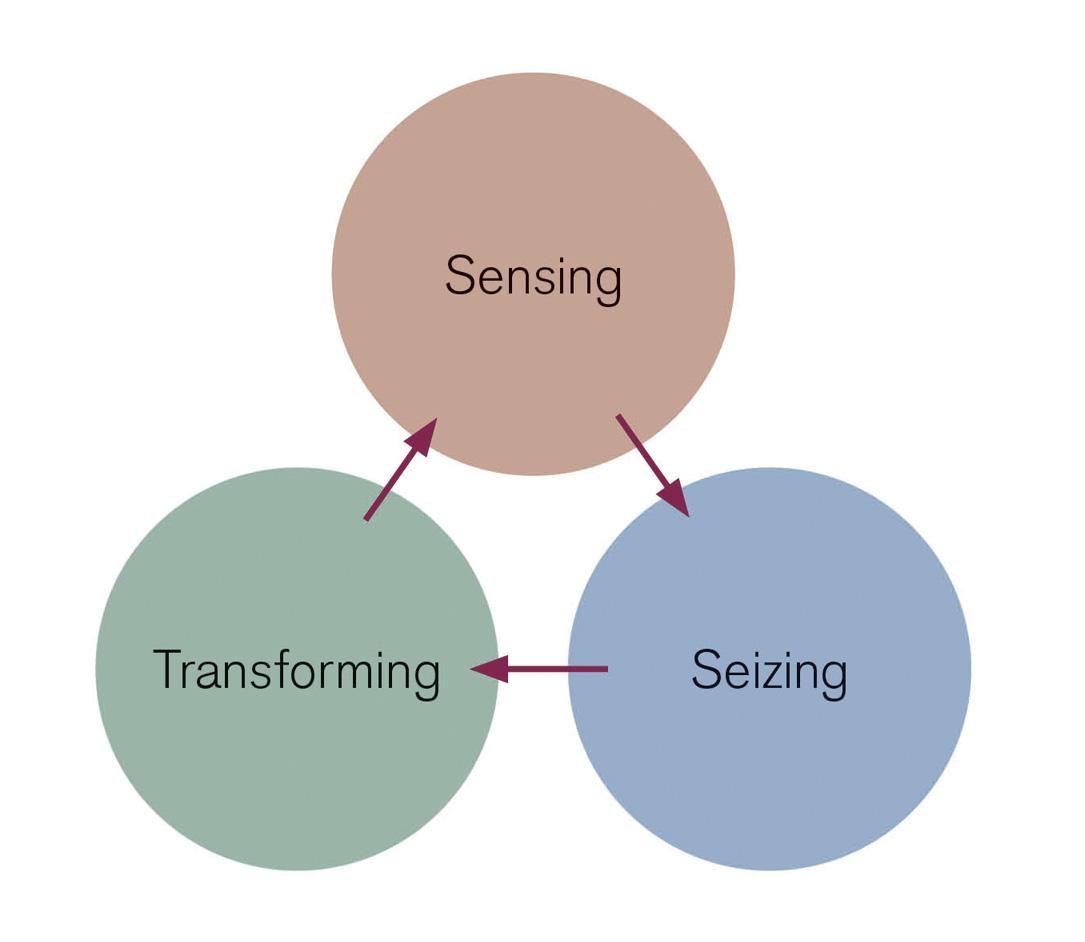Logistics ViewUsing Japanese-style Corporate Management to Compete in an Era of DX and Digital Twins
With global paradigms being shaken up by the COVID-19 pandemic, there is growing interest in "dynamic capability," the ability to adapt in response to change. This ability characterizes the essence of Japanese companies that are, or have been, successful. It is a boon for DX (digital transformation) which many companies are tackling as an urgent challenge. We spoke with Professor Kenshu Kikuzawa of the Keio University Faculty of Business and Commerce, and Graduate School of Business and Commerce.

Kenshu Kikuzawa
Professor, Faculty of Business and Commerce, and Graduate School of Business and Commerce, Keio University
Your research theme of dynamic capability is attracting a great deal of interest.
Dynamic capability is a concept that was advanced by David J. Teece of the University of California, Berkeley in the 1990s. I interpret it as the ability to adapt in response to change. It's been a much-discussed topic in Europe and America ever since then, but it hadn't attracted much attention in Japan. I think that it's started to draw people's interest recently because it featured in the METI White Paper on Monozukuri 2020.
Dynamic capability characterizes the essence of Japanese companies that are, or have been, successful, and I think people have accepted that it's an essential ability for survival in a rapidly changing world.

Sensing environmental change
Reorganizing resources and transforming
Seizing opportunities
Fig. 1 The three dynamic capabilities
The social environment now is very different from in the 1990s due to increasing globalization and digitalization.
The expression "the new normal" is being widely used at the moment. I think we should probably perceive this as a term that goes beyond new lifestyles during the COVID-19 pandemic and its aftermath, and see it as one that signifies the normalization of instability and environments in a state of extreme flux. When something changes somewhere in the world it will have a considerable impact in a globalized society.
It's necessary to detect signs of change as soon as possible in order to respond appropriately. You can gain a sustainable competitive edge by recognizing the opportunities that always appear amidst change and adapting accordingly.
The important thing is to innovate by reorganizing existing resources rather than starting from scratch. This sequence is generated by dynamic capability, which is itself made up of three capabilities: detecting environmental change (sensing), grasping opportunities (seizing), and reorganizing resources and changing (transforming). (Fig. 1)
People's tacit knowledge is essential
for DX and digital twins
Is it the third capability (transforming) that makes dynamic capability so compatible with DX (digital transformation)?
Not only that. DX endeavors to create a better world using digital technologies. Progress in DX creates an environment where various data can be collated and processed. This boosts the sensing (detecting change) and seizing (grasping opportunities) capabilities, which is expected to lead to even more insights.
A topic that's attracting attention alongside DX is digital twins, namely reproductions of the physical world in virtual space. Simulations that mimic reality can be created on computers, and are expected to be used for purposes such as producing more accurate predictions of mechanical malfunctions and problems on production sites, or in the research and development of new equipment and systems.
How do you think humans and machines will coexist as digitalization progresses?
Machines are designed to relieve humans from having to do heavy labor, and human beings are often the model from which good machinery and systems are created. Even today, there are many cases where the manufacturing industry relies on the tacit knowledge of skilled workers. Skilled techniques that can't be explained verbally are not easy to reproduce in machines. Recently, however, robots are being developed that are fully capable of riding a bicycle, something which is a perfect example of tacit knowledge, so I do think that technologies are being honed to turn tacit knowledge into explicit knowledge. Japan should probably tackle the challenge of digital twins that leverage the tacit knowledge of human beings.
Japan is said to be a latecomer to DX, but it has many skilled workers, so the handling of tacit knowledge is an area with potential. When it comes to the analysis of data collected via DX, only humans are capable of making the necessary high-level decisions. Expert statisticians say that when they look at data, they use their intuition to judge authenticity and accuracy, this ability is another example of tacit knowledge. In the future, artificial intelligence (AI) will probably be in charge of analysis, but the foundational models are to be found in the tacit knowledge of experts. I expect that AI will learn inductively from human data.
There are good times and bad times
Resilient companies have devoted employees
What do Japanese companies need in order to display dynamic capability and innovate?
The important thing is the reorganization of resources which is part of the third capability, transforming. This also links up with organizational theory. Drucker, the well-known thinker on management, said that orchestration (the relationship between an orchestra and its conductor) is the ideal organizational form. The members of an orchestra are all experts in their own instrument. The conductor is there not to improve their performance skills, but to create the orchestra as a totality by making the best use of the individuality of its members.
The German word "Gestalt" means an organized structure or property that is more than the sum of its parts. A simple example is that of language. If you see c, a, and t they are nothing but letters of the alphabet, but when the letters are put together, they form a word that holds meaning, cat.
Similarly, Mendeleev's periodic table is also a gestalt. When he systematically arranged the 63 elements that were known at the time, Mendeleev found there were a number of blank spaces. He concluded that elements which were yet undiscovered belonged there. Elements were in fact discovered, as he had predicted, and the number of elements has now increased to 118. Many of them were discovered thanks to the gestalt known as the periodic table.
Which means that requirements for the reorganization of resources will become evident if there is a gestalt, won't they?
I'm not sure whether the expression of a gestalt should be described as a philosophy, a vision, or a mission, but an organization that has a gestalt with which its employees empathize is a resilient one. The gestalt is something that both insiders and outsiders regard as being typical of the company, and ultimately is made manifest in devotion to the company.
Airline companies that are struggling due to the COVID-19 pandemic have loaned some of their employees to companies in other industries. Companies that are willing to temporarily accept employees from another company are amazing, but I was also surprised that so many employees agreed to the secondment. This can only be due to their devotion to their company and shows that they want to work for their original company again someday. This large amount of secondment would be inconceivable in Europe or America. This flexibility is a strength of Japanese companies, and one reason why Japan has so many longstanding companies.
I certainly don't intend to idealize the past, but it is true to say that traditional Japanese management and dynamic capabilities go well together. For example, when a career track employee was informed that they were being relocated, they'd accept the transfer. There may not be as many relocations now as there used to be, but an organization will have problems if it can't move personnel in response to changes and get the right people in the right place, so companies should retain the necessary flexibility.
An awareness of legal reform and social changes
should trigger transformation
Please tell us about cases where demonstrating dynamic capabilities led to success.
FUJIFILM is a perfect example. When the photographic film market shrank and the continuation of its main business was in jeopardy, the company reorganized its internal expertise, technologies, and resources to succeed in a new business, and successfully established itself a second time. I was surprised to hear that FUJIFILM was moving into the cosmetics industry, however it was not developing technologies from scratch but basing its new business on the collagen technologies employed for its photographic film. There's a special form of distribution for cosmetics, and it would be difficult for FUJIFILM as a newcomer to utilize the same routes, so the company launched the new business via mail-order sales. After its success in the cosmetics industry, FUJIFILM is now engaged in a new challenge: regenerative medicine.
Similarly, Rohto Pharmaceutical has also successfully established a new cosmetics business now that the eye drops market has matured. Existing cosmetics manufacturers allocate most of their resources to brand strategies, but Rohto Pharmaceutical leveraged technologies it had developed for its mentholated ointment to emphasize functionality in its products, such as highly concentrated vitamin C. Since then, it has also moved into the Chinese medicine market.
The background to these examples is legal reform. As their key businesses of film and eye drops reached a turning point, an awareness of change in the form of revisions to the Japanese Pharmaceutical Affairs Law led to a reorganization of their resources and to transformation. That can be described as dynamic capability.
Is it possible to demonstrate dynamic capability even without external changes such as legal reform?
Yes, of course. A company has three directions in which it can grow. (Fig. 2) The first is horizontally. Expanding within its industry gives it the advantage of scale and gains it a competitive edge. However, it may violate antitrust laws if it becomes increasingly monopolistic. The second is multi-directionally. It may be more cost-effective to manufacture multiple products at the same company rather than make them separately. The business development of railway companies is this kind of diversification. The third is vertically. There are many examples of this since it handles everything from parts procurement to product manufacturing and sales in an integrated manner. Actually, however, the third direction has been a subject of discussion among researchers.
The issue was whether it violates antitrust laws. A long-term contract is sufficient in the case of transactions that are technologically necessary, and there is no need for integration. Professor Teece's mentor, Professor Williamson, argued that business-to-business transactions involve mutual bargaining, which becomes a burden, so the businesses are integrated. In other words, since the pursuit of efficiency is not the main purpose of vertical integration, he concluded that it is not a move toward monopolization and does not violate antitrust laws.
Please enlarge the screen to view

(1) Expand its scale within its industry (2) Expand business multi-directionally (3) Integrated expansion, from procurement to sales
Fig. 2 Three directions in which a company can grow
With regard to that, Professor Teece argued that capabilities are also involved in the aims of vertical integration. I believe Apple is a typical example of that. New technologies are used in the stream of products Apple develops, which the company wants to promote to customers. However, it would be hard to get consistent promotion from retailers, so the company engaged in the vertical roll-out of directly managed Apple stores.
The context that gave birth to the concept of dynamic capability is fascinating, isn't it?
There are many cases of vertical expansion where, like Apple, the companies reorganized resources on the basis of necessity and expanded their capabilities vertically, or they acquire companies compatible with new technologies and innovations. Gestalt (totality) is the basis on which such strategies are considered, and it can be said that, in the case of Japanese companies, dynamic capabilities are only generated when there is a feeling of devotion to the company, which is a tremendous strength of Japanese businesses. There are many employees who are devoted to their company, particularly in the manufacturing industry, and I truly hope that management will not forget that.

Kenshu Kikuzawa
Born in 1957. After graduating from the Faculty of Commerce, Keio University and completing his doctorate at the Graduate School of Business and Commerce, Keio University, his career path includes posts such as a professor at the National Defense Academy of Japan before taking up his current position in 2006. He has worked as a visiting researcher at NYU Stern School of Business and UC Berkeley. He currently serves in positions such as a director of the Japan Academy of Business Administration. His publications include "Successful Japanese Companies Essentially Have Something in Common: Dynamic Capability Management Studies" (Asahi Shimbun Publications Inc., 2019. In Japanese), "A Dynamic Capabilities-based Strategic Management" (CHUOKEIZAI-SHA, 2018. In Japanese), "Irrational Reform" (Asahi Shimbun Publications Inc., 2018. In Japanese), and "Introduction to Organizational Economics New Institutional Economics Approaches" (Yuhikaku Publishing Co., Ltd., 2016. In Japanese).
- *This article is based on the content of "Using Japanese-style Corporate Management to Compete in an Era of DX and Digital Twins" featured in DAIFUKU NEWS No. 231 (published in July 2021).
